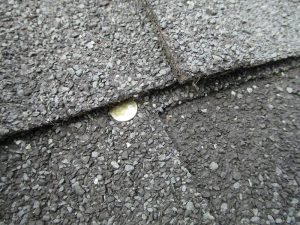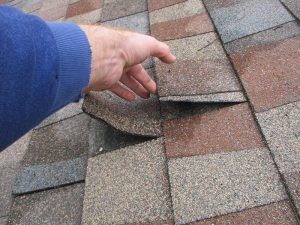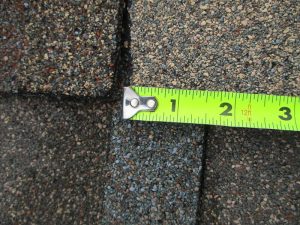Real Problems with a “New Roof”
Roof condition is one of the most asked about items during a home inspection. Real estate listings love to push “new roof” as a selling point, and likewise, buyers often think that a “new roof” means that there should be no problems to expect for many years.
It’s easy to see why people are concerned; roofs are expensive and they’re a repair that people often see, so they’re familiar with. Who hasn’t noticed with the dumpster arrives and the neighbor’s have a new roof installed? We all see it, and we all know it’s expensive. I’m going to show you why having a new roof installed doesn’t necessarily mean that it has a problem free thirty years ahead of it.
They Missed?

Here’s a classic case of what’s called a “shiner.” That means that the shine from the nail is visible in the roof covering. This was on a new roof covering of a house that I inspected last year. One of the selling points was that it had a new roof; the seller even went so far as to name the company that installed it. I found no less than 27 nails showing in this roof. There should be zero. Each nail is a potential leak. Being off by an inch with the nail gun can lead to big problems in the future!
It’s a “New” Old Roof
This roof was on a flipped house that I recently inspected. This is a case of the roofer using

shingles that were probably purchase second hand. The tar strips, meant to seal the shingles down, were dried up before the shingles were ever installed. As a result, every single shingle on this roof will eventually blow off. They’re not wrong when they call it a “new roof,” but that’s not the whole story.
Stagger? What is Shingle Stagger?

Shingle stagger, or shingle offset, is the distance between the butt joints of shingles from row-to-row. Manufacturer’s have specifications for this, with most falling at around 6″ or greater distance between shingles. Anything less than four inches between shingles can allow water to run along the seams and eventually work its way behind the shingles into the wood sheathing and attic. In simple terms; the roof can leak. It’s often difficult to detect the source of these leaks, since the water may show up in another area inside the attic and there is no physical damage in the roof covering.
In Closing: Your Home Inspector Can Save You
Your Home Inspection is the most important defense that you have against buying a property with a “new roof” having installation defects that will lead to failure. Make sure the Home Inspector that you hire walks on the roof, if familiar with proper installation techniques and knows how to spot all the problems with a bad “new roof.”

